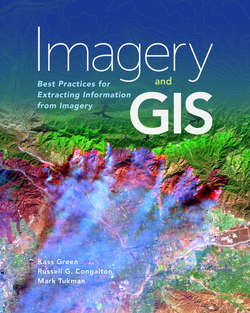Читать книгу Imagery and GIS - Kass Green - Страница 33
На сайте Литреса книга снята с продажи.
Source of Energy: Active versus Passive Sensors
ОглавлениеPassive sensors collect electromagnetic energy generated by a source other than the sensor. Active sensors generate their own energy, and then measure the amount reflected back as well as the time lapse between energy generation and reception. Figure 3.5 illustrates the difference in how active and passive sensors operate.
Figure 3.5. Comparison of how passive and active sensors operate
Most remote sensors are passive sensors, and the most pervasive source of passive electromagnetic energy is the sun, which radiates electromagnetic energy upon objects on the earth that either absorb/emit, transmit, or reflect the energy. Passive energy can also be directly emitted from the earth, as from the eruption of a volcano or a forest fire. Examples of passive remote sensors include film aerial cameras, multispectral digital cameras, and multispectral/hyperspectral scanners. Passive sensors are able to sense electromagnetic energy in wavelengths from ultraviolet through radio waves.
Passive sensors fall into three types: framing cameras, across-track scanners, and along-track scanners. Framing cameras either use film or matrixes of digital arrays (e.g., UltraCam airborne sensors, PlanetLabs satellite sensors). Each frame captures the portion of the earth visible in the sensor’s field of view (FOV) during exposure. Often, the frames are captured with greater than 50 percent overlap, which enables stereo viewing. Each image of a stereo pair is taken from a slightly different perspective as the platform moves. When two overlapped images are viewed side by side, each eye automatically takes the perspective of each image, enabling us to now “see” the overlapped areas in three dimensions. With stereo frame imaging, not only can distances be measured from the aerial images, but so can elevations and the heights of vegetation and structures, discussed in detail in chapter 9.
Most across-track scanners (also called whisk broom scanners) move an oscillating mirror with a very small instantaneous field of view (IFOV) side to side as the platform moves. Each line of the image is built, pixel by pixel, as the mirror scans the landscape. Developed decades before the digital frame camera, across-track scanners were the first multispectral digital sensors and were used in multiple systems including the Landsats 1-7, GOES, AVHRR, and MODIS satellite sensors, and NASA’s AVIRIS hyperspectral airborne system.
Along-track scanners (also called push broom scanners) rely on a linear array to sense entire lines of data simultaneously. Rather than mechanically building an image pixel by pixel or by groups of pixels, the along-track scanner builds an image line by line. Along-track scanners have higher spectral and radiometric resolution than across-track scanners because the sensor can spend more time (termed dwell time) over each area of ground being sensed. Like across-track scanners, along-track scanners often also use a dispersing element to split apart the incoming beam of electromagnetic energy into distinct portions of the electromagnetic spectrum to enable the collection of multispectral imagery. Developed 30 years ago, along-track scanners are a more recent development than across-track scanners. Many multispectral satellite systems (e.g., WorldView-3, Landsat 8) rely on along-track sensors, as do the Leica Airborne Digital Sensors.
Active sensors send out their own pulses of electromagnetic energy, and the sensor measures the echoes or returns of the energy as they are reflected by objects in the path of the pulse. For example, consumer cameras with flash attachments are active systems. Active remote sensors include lidar (light detection and ranging) systems, which generate laser pulses and sense electromagnetic energy in the ultraviolet to near-infrared regions of the spectrum, and radar (radio detection and ranging) systems, which generate and sense energy in the microwave range. An advantage of active systems is that they do not rely on the sun, so acquisitions can be made at times when the sun angle is low or at night. An additional advantage of radar systems is that the long wavelengths of microwaves can penetrate clouds, haze, and even light rain.
